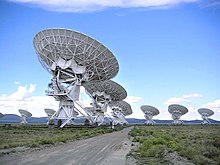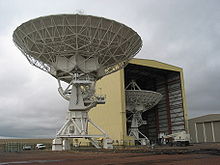Very large array
The Very Large Array ( VLA ), officially called Karl G. Jansky Very Large Array since 2012 , is an interferometer for astronomical observations in the radio range. The facility is located on the San Agustin Plain between the cities of Magdalena and Datil in New Mexico in the United States , 78 miles west of Socorro by road . The telescope is located at an altitude of 2124 m and is part of the American National Radio Astronomy Observatory (NRAO).
construction
The VLA consists of 27 individual radio telescopes with a diameter of 25 meters and a weight of 230 tons, which can be placed on different stations along three inverted Y-shaped tracks, each 21 km in length. The directions run every 120 ° in the direction of 4, 8 and 12 o'clock, the last so to the north. Each of these four- rail tracks consist of 4 rails, which form 2 tracks of (approximately) standard gauge, which in turn are about 7 m apart from each other. The antennas are placed in short cross tracks that go off at right angles. A works train can run on a standard gauge track.
According to the principle of the interferometer, it reaches the angular resolution of a telescope with a diameter of 36 km. The VLA is currently the most sensitive radio interferometer for the centimeter wave range and works at wavelengths from 4 m to 7 mm (corresponds to a frequency between 75 MHz and 43 GHz ). The best angular resolution is 0.05 arc seconds (at a wavelength of 7 mm).
Usually four different settings of the telescope are used. These are designated with the letters A for the largest setting up to D if all bowls are pulled together to 600 m.
The VLA also serves as the control center for the Very Long Baseline Array (VLBA), a Very Long Baseline Interferometry array with a total of ten 25-meter telescopes, which are arranged between Hawaii in the west and the Virgin Islands in the east. This creates the largest astronomical instrument in the world.
A base length B of approx. 8000 km is available for the wavelength λ of 25 mm (12 GHz) , from Hawaii to the Virgin Islands . The angular resolution δ that can be achieved with this is approx. 0.6 milli-arcseconds (with δ ~ λ / B · 180 / pi · 60 · 60 in arc seconds). If the resolution were available in the optical range, one could see details the size of a meter on the moon.
history
The VLA was established in the 1970s on the San Agustin Plain, about 80 km west of Socorro, New Mexico, USA, following a resolution by the US Congress in August 1972. The first antenna was installed in September 1975. The plant was to total expenditure of 78,500,000 finally 1980 USD opened and the American National Radio Astronomy Observatory operated (NRAO).
In 2012 the VLA was renamed Karl G. Jansky Very Large Array in honor of the founder of radio astronomy after a comprehensive technical modernization .
A further development to the 'Expanded' VLA (EVLA) is being planned. This could further increase the sensitivity of the instruments, the frequency range and the resolution . The proposal envisages installing additional systems in San Agustin and setting up up to 8 additional telescopes up to 300 km away and connecting them with fiber optic cables.
After upgrades that improved the measuring accuracy of the instrument by a factor of 10, a radio map of the planet Jupiter was created in 2016 .
media
The VLA plays an important role in the 1985 published novel Contact by Carl Sagan , although it is shown larger by a multiple (131 telescopes) and Argus Array is renamed. In the 1997 Hollywood film adaptation of Contact , many of the exterior shots were shot on the premises of the VLA; the nearby canyon shown is Canyon de Chelly in neighboring Arizona . In the film, however, the VLA is back to its actual size of 27 telescopes.
For the films 2010: The year in which we make contact , Independence Day and Terminator: The Redemption , scenes were also filmed on the premises of the VLA.
Visitors
The facility is open to visitors all year round. A visitor center, museum and souvenir shop, as well as a walking tour are offered.
See also
Web links
- Homepage of the VLA (English)
Individual evidence
- ↑ Satellite view google.com/maps, accessed July 12, 2020.
- ↑ Bill with google
- ↑ Imke de Pater et al., Peering through Jupiter's clouds with radio spectral imaging , Science 2016, Vol. 352, Issue 6290, pp. 1198–1201 doi : 10.1126 / science.aaf2210
Coordinates: 34 ° 4 ′ 43 " N , 107 ° 37 ′ 6" W.



